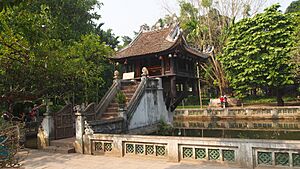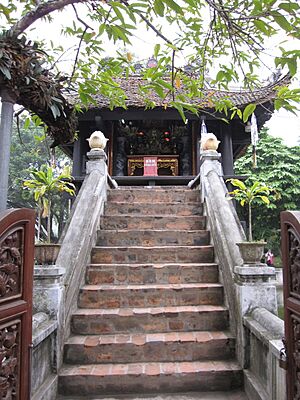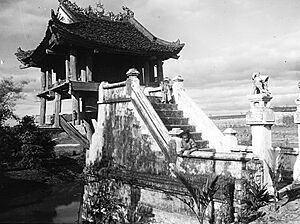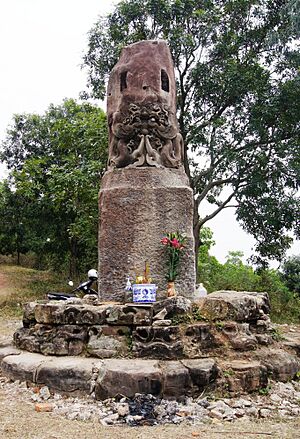One Pillar Pagoda facts for kids
Quick facts for kids One Pillar Pagoda |
|
|---|---|

One Pillar Pagoda
|
|
| Religion | |
| Affiliation | Buddhism |
| District | Ba Đình |
| Province | Hanoi |
| Location | |
| Country | Vietnam |
| Architecture | |
| Completed | 1049 |

The One Pillar Pagoda (called Chùa Một Cột in Vietnamese) is a historic Buddhist temple. It is located in the central Ba Đình area of Hanoi, the capital city of Vietnam.
This pagoda is part of a larger group of buildings known as Diên Hựu tự, which means 'pagoda of extended blessings'. The most famous part is Liên Hoa Đài, or 'the lotus pedestal'. This is a special temple built on a single pillar. The original pagoda was built in 1049. It was later improved in 1105. The One Pillar Pagoda is seen as one of Vietnam's most important temples, along with the Hương Temple.
Contents
History of the Pagoda
Building the Temple
Emperor Lý Thái Tông built the temple. He ruled Vietnam from 1028 to 1054. The emperor did not have a child. One day, he dreamed he met a holy figure called Avalokiteshvara. This figure was sitting on a lotus flower and gave him a baby son.
Later, Lý Thái Tông married a peasant girl. They had a son, just like in his dream. To show his thanks, the emperor built the temple in 1049. A monk named Thiền Tuệ told him to build it. It was to be a pillar in the middle of a lotus pond, just like in his dream.
The temple was in the Tây Cấm Garden in Thăng Long, which is now Hanoi. Before it opened, people prayed there for the emperor's long life. During the Lý dynasty, the temple hosted a yearly royal event. This event celebrated Vesak, the birthday of Gautama Buddha. The emperor would perform a Buddha-bathing ceremony. Many monks and people came to watch. After the ceremony, the emperor would free a bird, and others would follow.
Changes Over Time
Emperor Lý Nhân Tông improved the temple in 1105. A large bell was made in 1109. This bell was one of Vietnam's four biggest artworks at the time. However, it was too big and heavy to install.
Since it could not be rung on the ground, it was moved. It was placed in a field near Nhất Trụ Temple. Many turtles lived in this area. So, the bell became known as Chuông Quy Điền, meaning 'bell of the turtles' field'.
In the early 1400s, the Ming dynasty from China took over Vietnam. In 1426, the future Emperor Lê Lợi fought against the Chinese. As the Ming forces retreated and needed weapons, their general ordered the bell to be melted down. The copper from the bell was used to make weapons.
Later Restorations
During the Nguyễn dynasty, the pagoda was fixed and rebuilt. This happened between 1840 and 1850, and again in 1922.
In 1954, the pagoda was damaged by an explosion. It was not destroyed by the French. A Vietnamese officer in the French Army caused the damage and was punished. In 1955, the Ministry of Culture of Democratic Republic of Vietnam rebuilt the pagoda. They used the old architectural style from the Nguyễn dynasty.
Pagoda Architecture
Original Design
The pagoda was improved in 1105. Records from Đại Việt sử ký toàn thư describe these changes. The emperor ordered the Diên Hựu pagoda to be more beautiful. A lake called Liên Hoa Đài lake (Lotus Station's lake) was dug. It was also called Linh Chiểu lake.
Around this lake, there was a walkway. Outside the walkway, another lake called Bích Trì Lake was dug. Bridges were built to cross these lakes. A stupa was also built in front of the temple.
In 1999, a researcher named Nguyễn Hùng Vĩ found something interesting. He showed that the One Pillar Pagoda's design is like an old stone pillar from Dạm Pagoda. Another expert, Dr. Trần Trọng Dương, believes the original Diên Hựu Pagoda was designed like a Mandala. A Mandala is a special Buddhist symbol with geometric shapes.
In 2020, a group of researchers proposed a plan to rebuild the original Diên Hựu pagoda. They based their ideas on the Lý dynasty's style. The main part of their design was the Lotus Station (One Pillar Pagoda). It would be a hexagonal building on one pillar, shaped like a lotus flower. They used 3D images and virtual reality to show their ideas.
1955 Restoration
The temple is made of wood and sits on a single stone pillar. This pillar is 1.25 meters (about 4 feet) wide and 4 meters (about 13 feet) tall. The pagoda is designed to look like a lotus blossom. The lotus is a Buddhist symbol of purity because it grows beautifully from muddy water.
After being damaged in 1954, the pagoda was rebuilt. A copy of the pagoda was also built in Thủ Đức in Saigon in the late 1950s and early 1960s.
See also
- List of Buddhist temples in Hanoi




